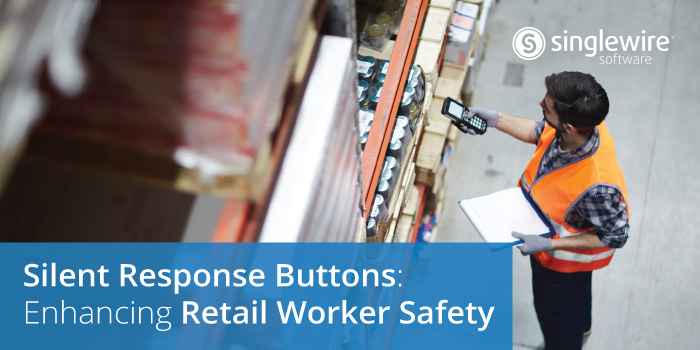The Evolving Landscape of Retail Worker Safety
The safety and well-being of retail employees have become increasingly important, especially with rising concerns about workplace incidents. Retailers are actively seeking effective ways to protect their employees and create a secure environment. In New York, the Retail Worker Safety Act was recently amended, requiring retailers with more than 500 retail employees statewide to provide silent response buttons to alert internal staff (security officers, managers, or supervisors) when assistance is needed. This initiative aims to give employees the means to immediately alert others when they need help or notice an issue. This blog post will explore the different types of silent response buttons, methods for silent alerting, and how these differ from traditional panic buttons.
Five Types of Silent Response Buttons
Retailers have several options available to them when implementing silent response buttons for their staff:
- Configured on a Phone: Silent response buttons can be integrated into existing phone systems, allowing employees to quickly trigger an alert using a designated code or button.
- Mounted Button: Physical silent response buttons can be strategically placed throughout a store or at checkout stations, providing easy access for employees in various locations.
- Mobile App: A dedicated mobile app can empower every employee with a silent response button on their personal device. This option offers flexibility, working both within the store and in surrounding areas like parking lots should they need help.
- Keyboard Shortcuts: While desktop computers might not be universally used in retail settings, keyboard shortcuts can be a viable option for employees stationed at desks or registers.
- Wearable Device: Wearable devices can be provided to all employees, ensuring they have a silent response button readily accessible at all times.
When connected to a mass notification system, these physical buttons can have an associated location of where they are placed in the store, while mobile apps can provide real-time location information, giving internal staff critical insights about where an incident has occurred so they know where to direct assistance.
Types of Silent Alerting
Silent alerting plays a crucial role in minimizing panic and offering a discreet way to notify the appropriate personnel about an incident. Several methods can be used for silent alerting:
- SMS Text Messaging or Push Notifications: These alerts can be delivered directly to designated individuals’ phones, providing immediate notification of an issue.
- Email: While email may be considered a less immediate form of communication, it can still serve as a silent alert, although it may be easily overlooked.
- Desktop Pop-up: A desktop pop-up alert can overtake a computer screen, immediately notifying a staff member of an issue.
- Digital Displays: Digital displays, whether on signage or desk phones, offer a visual means to relay a message and attract someone’s attention discreetly.
- Strobes: Flashing lights can serve as a silent visual indicator of an event, particularly useful in noisy environments.
Using text and visuals when silent response buttons are activated gives retailers a better chance of grabbing people’s attention quickly, so they can respond as fast as possible and minimize risk.
The Difference Between a Silent Response Button and a Panic Button
The original Retail Worker Safety Act called for panic buttons that directly contacted outside first responders. While the language has been amended to focus on silent response buttons for internal staff, the core difference lies in how retailers configure these systems. While direct connection to first responders is no longer mandated by the law, it’s still a capability retailers should consider implementing. The right mass notification software can facilitate both internal and external alerting. Extending the reach of these buttons to first responders means help can arrive sooner, and responders have the necessary context to provide assistance effectively.
While New York is leading the way with legislation requiring silent response buttons, other states are likely to follow suit. As worker safety remains a paramount concern, the need for effective solutions will continue to grow. At Singlewire Software, our mission is to provide organizations with the tools they need to communicate effectively and create safe environments. Our mass notification solutions and software offerings can help retailers implement robust silent response button systems, enabling them to protect their employees and foster a culture of safety. Taking proactive measures is not just about compliance; it’s about creating a workplace where everyone feels safe and protected. Visit our panic buttons page to learn more about options for silent alerting.
